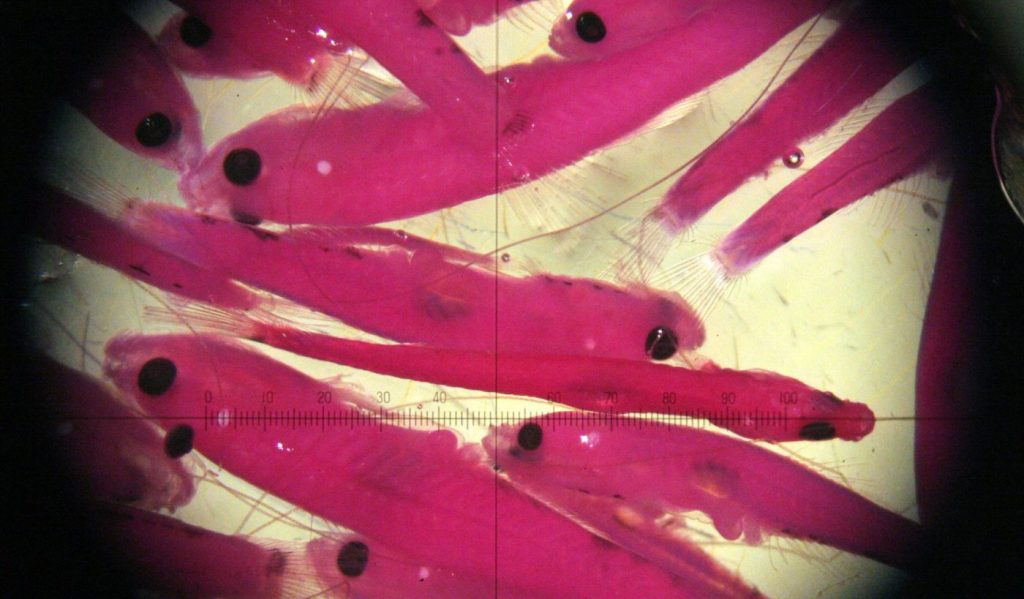By Ari Plachta | Sacramento Bee
Just east of the San Francisco Bay, a steel bucket holding 90 gallons of water is strained to rescue precious cargo. The metal roars as it spins, dispelling more and more water, to reveal, finally, a wriggling pair of juvenile Chinook salmon.
These young, 2-inch long fish were drawn into danger by giant pumps that push water south to millions of Californians and farms. Saving them from likely peril has been the core purpose since 1968 of the John E. Skinner Delta Fish Protective Facility.
But the facility been the subject of considerable attention recently for a spike in fish deaths, drawing the ire of environmentalists and anglers. That’s not to say farmers are happy either, as pumps deliver less water despite a second year of drought-busting storms.
A Sacramento Bee analysis of data from the Department of Fish and Wildlife shows that since 2002, state and federal water pumping from the Sacramento-San Joaquin River Delta killed an estimated 600,000 Chinook salmon and 50,000 steelhead trout.
“That is a lot of fish, including a lot of commercially viable fish and a lot of endangered fish, to kill year in, year out,” said Jon Rosenfield, science director at the environmental watchdog San Francisco Baykeeper.
“No organism is designed to withstand additional mortality ad nauseam on top of all the other things they’re struggling with,” he said. “It’s no wonder the populations are declining. Some years its a big impact, some years less, but it’s always there.”
In this rare year of average rainfall, scrutiny of the pumps underscores a perennial tension baked into California’s water delivery system: The more water pumped out of the beleaguered Delta, the harder the hit to beleaguered fish.
The Department of Water Resources says pumping for exports this year has been relatively minimal due to environmental restrictions, and that the overall population numbers for protected fish are high despite the spike at the pumps.
This year has been especially deadly, state figures showed. During February and March, pumps killed an estimated 3,600 winter-run Chinook, the highest number killed in any two-month period in 20 years.
And about 3,200 steelhead died in February and March, the highest number since 2007.
The exact reason for this year’s high mortality is unclear, fish scientists have said. And Delta pumps are just one of many threats to fish survival in California’s main waterways, including habitat loss and drought.
But they agree it’s one that shouldn’t be ignored.
Catching the lucky few
California’s large water pumps, as well as nearby federal pumps that draw water to the canals of the Central Valley Project, are so powerful they often change the natural flow of water in parts of the south Delta.
The risk for fish is not simply that they could be killed by the pump’s machinery, state scientists say, but also that they will be incidentally pulled into waters where predators are waiting for them.
The pumps feed water from the Delta into California’s state and federal water projects, with he bulk of it supplying state’s powerhouse agricultural industry and the rest to cities.
The entrance to the state’s Harvey O. Banks Pumping Plant opens to a shallow holding reservoir called Clifton Court Forebay. It’s filled with nonnative striped bass and other predator fish that feed on juvenile salmon, steelhead trout and other native species.
State studies have shown that about 75% of the young salmon that enter the forebay are killed by predators. As part of those studies in years past, state scientists attempted to capture nonnative fish and move them elsewhere with little success.
The fish that do manage to evade predators encounter an elaborate network of underwater barricades at the fish protection facility, about 2 miles from the pumps. Metal louvers guide fish into the facility instead of toward the pumps.
The fish pass through large pipes, enter other large channels and finally travel through smaller pipes into the building where they end up in the giant concrete tanks. State scientists say close to 80% of fish that reach the fish facility are collected via this system.
Once collected, the fish are hauled via truck to be released back into the Delta. These are the fish counted as “salvage,” and used by state scientists to estimate the number of fish estimated to be “lost” to the system with a calculation based on past studies.
“CDFW did a number of studies from the ’80s all the way through the early ’90s looking at losses throughout the project,” said Javier Miranda, DWR environmental program manager for fisheries monitoring at the state water project.
His role in the last several years has been to recreate those studies with more detail, to see if the state’s water delivery systems still create the same level of fish loss.
“The fact of the matter is, yes, things are the same they were 20 years ago,” he said.
Some environmental groups have advocated for fish screens along the forebay gates to prevent fish from being drawn in, but state scientists argue that wouldn’t necessarily solve the problems.
Trends in state data show that the estimated loss of fish at the pumps is highly variable depending on the year.
Since 2002, an average of 53,000 Chinook or steelhead were estimated killed during years state and federal facilities pumped at least 5 million acre-feet of water. In the years they pumped less than 4 million, only an average of 8,200 died.
“We do everything that we can possibly do to improve fish survivability and return them to the Delta alive and kicking,” said Trent Schaffer, branch manager for the state water project’s Delta field division. “That’s a simple answer. We take our job very seriously.”
No easy solutions
Historically, California’s mighty rivers teemed with salmon. Now dams block them from reaching cold mountain streams to spawn. Government-run hatcheries rear and release millions of salmon a year to help prevent population decline.
But those efforts haven’t worked, and salmon as well as other native fish are in deep trouble. According to some estimates, about 5.5 million salmon once returned to California rivers in the 19th century. Fewer than 200,000 fish on average were counted by state and federal fisheries in the last five years.
Now the commercial salmon fishing season, which relies on fall-run Chinook, is closed for the second year in a row. Spring-run are threatened, and winter-run Chinook are endangered under the Endangered Species Act along with steelhead trout.
State officials and scientists acknowledge shortcomings in their facilities, such as the predator-filled forebay, but say they are improving operations.
As one example, DWR installed a barrier of bubbles, flashing lights and pulsating sounds in the north Delta to deter migrating fish from entering the more dangerous south Delta, where the dangerous forebay sits, and guide them toward San Francisco Bay.
The department also said it is using genetic testing technologies to help more quickly distinguish between endangered and non-endangered salmon species, which they say enhance fish-collection efforts with better management.
Gov. Gavin Newsom has emphasized his commitment to salmon population recovery. In January, he unveiled a salmon strategy plan, detailing a range of enhanced measures such as habitat restoration and hatchery modernization.
The department has also sought to improve the operation at the fish-collection facility by incorporating genetic testing technologies to differentiate more accurately between endangered and non-endangered types of salmon.
Despite these efforts, managers of the State Water Project have so far limited this year’s allocation to 40% of suppliers’ full allotments the same level that federal officials have set for agricultural water districts south of the Delta.
Related Articles
1950s-era ocean liner sinking into Delta, leaking oil and fuel
$20 billion: The Delta tunnel’s new price tag
Independent fish scientist Brad Cavallo said increased pumping could actually benefit fish. He pointed to tagging studies that he said shows salmon from the San Joaquin River are more likely to survive through the Delta than fish that are not affected by the pumps.
“If anything, regulatory policies intended to protect juvenile salmon have made the problem worse,” said Cavallo, a scientific advisor to the Coalition for a Sustainable Delta. “Pumping restrictions have reduced river flows and limited access to the one of the highest survival routes for fish originating from the San Joaquin River basin.”
But Rosenfield, the Baykeeper scientist, referenced core goals of the the Delta Protection Act and the need to prioritize conservation and reduction of our reliance on water from the estuary.
“We’re supposed to be operating dual goals in a deathmatch tension. One is to increase the supply or increase the reliability of the supply of water, and the other goal is to protect the ecosystem,” he said. “No one talks about the third goal, which is to reduce reliance on the Delta.”


